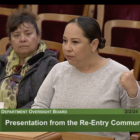Nancy Taylor, a longtime resident of San Jose with an excellent credit rating, was startled when she began receiving phone calls and letters from debt collectors in 2007.
The incessant calls and letters came from people claiming, erroneously, that she owed an outstanding balance of about $2,000 on her Sears charge card. The department store confirmed that the debt was not hers, but that made no difference.
Ms. Taylor began responding to each letter, explaining that it was a case of mistaken identity. To no avail. In 2008, she was sued for $1,936 by Erica Brachfeld, a Southern California lawyer who was representing a company that had bought a bundle of unpaid debt, including the debt falsely ascribed to Ms. Taylor.
“My heart started pounding, and then I got mad,” said Ms. Taylor, a marriage and family therapist. “You feel you’re being shamed.”
When Ms. Taylor went to trial in 2009, the judge dismissed the case against her. She also won a countersuit claiming that the company Ms. Brachfeld represented, LVNV Funding, violated the Fair Debt Collections Practices Act.
Representatives for the debt-collection company and Sears both declined to comment.
Ms. Taylor’s predicament is increasingly common as debt collectors have begun using litigation as a tool to collect on aging debts. Critics say the practice clogs the courts and turns the credit card companies’ debtor lists into free-fire zones that sometimes target the innocent.
In the Bay Area, a coordinated response to these practices is being developed, as a loose-knit group of public-interest lawyers pools resources to fight what they see as a misuse of the court system.
Some of those being sued have contributed to their own predicament. While some, like Ms. Taylor, owe nothing, and some have had their debt discharged during bankruptcy, others are in arrears on payments, but hope to negotiate new payment schedules. Some simply do not intend to pay.
“We found that these law firms count on a huge percentage of the people that they sue defaulting,” or not responding to the legal actions, said Osha Neumann, a lawyer with the East Bay Community Law Center, which is affiliated with the University of California, Berkeley, and organizes and trains local lawyers in debt-collection defense. “The debtors don’t respond because they don’t know how, and that’s how the debt buyers make their money.”
As a result of the default judgment, debt buyers can either garnish wages and bank accounts or require payment from the debtor.
About $100 billion in credit card debt is sold annually in the United States, and debt buyers will typically purchase a portfolio of delinquent debt from creditors for between 35 and 75 cents on the dollar. After collecting on this “fresh” debt, or hiring a third-party to do the work for them, these primary or secondary debt buyers can then bundle and sell the older, harder-to-collect accounts to other debt buyers for as little as less than half a cent on the dollar.
Because some lawsuits against debtors are inherently problematic — their only source of income is public funds, or the debt is too old for collection — local legal groups and courthouse self-help clinics are trying to stave off the default judgments among Bay Area residents.
Organizations like the Bar Association of San Francisco, for example, hold regular legal clinics specifically focused on debt-collection defense.
There is a growing need for such knowledge. The number of collection cases has “risen considerably in the past year or so,” said Judge Winifred Smith of the Alameda Superior Court, who has assisted with the training sessions for lawyers.
Statewide, the category of lawsuit under which these collections cases fall has increased by 20 percent in the past five years. An estimated 96,000 consumer debt-collection cases were filed in 2009 in Alameda, Contra Costa and San Francisco Counties alone, up from about 53,665 in 2007. A significant number of debt-collection cases appear to be filed by debt buyers dealing in aging debt because “entities that purchase delinquent debt often use collection law firms as their primary tool for recovery,” according to a 2009 report by the federal Government Accountability Office.
“We have a budget problem in California right now,” said Fred W. Schwinn of the Consumer Law Center, whose private firm represented Ms. Taylor. “On the third Wednesday of the month, the courts are dark because we don’t have the money to keep them open. We have no money because the caseloads are up at an all-time high. Who is filing all of these civil cases? Creditors and debt buyers are swamping the California court system with debt-collection cases.”
Among consumer advocacy lawyers, Ms. Brachfeld is considered exceptional in the volume of her filings. She acknowledged in court documents that she files between 500 and 2,500 cases a month. Ms. Brachfeld, who has filed paperwork to run at least seven law offices in some states where she is not licensed to practice, is also the defendant in a class-action lawsuit filed in a United States District Court in San Jose by a Mountain View resident who claims that she violated the Fair Collections Debt Practices Act.
Ms. Brachfeld’s lawyer, Stephen H. Turner of the firm Lewis Brisbois Bisgaard & Smith declined to comment on the case. Ms. Brachfeld did not return calls seeking comment.
Collection industry representatives say that collection law firms operate under a business model that anticipates a large caseload.
Harvey M. Moore, president of the California Creditors Bar Association, said, “We’re not built on the same model of a traditional law firm in that we do not bill an hourly rate for our work. We are not paid unless we collect.”
The volume practice of lawyers like Ms. Brachfeld, coupled with defendants’ overall lack of responsiveness to these suits, is at the heart of the concern for consumer advocacy lawyers.
According to debt-collection industry estimates, between 75 and 80 percent of debtors in these cases do not respond to their lawsuits, and 95 percent of these result in default judgments. The Federal Trade Commission, which oversees the debt-collection industry, puts the non-response rate closer to 95 percent.
Mr. Moore of the California Creditors Bar Association said, “I truly believe litigation is a last resort.”
But the impact of these tactics on the courts bothers some people, like Mary Spector, an associate professor Dedman School of Law at Southern Methodist University who is studying debt-buyer lawsuits in Dallas County. “My view, because I represent consumers in a law school clinic, is that parties should use the court for genuine disputes,” she said. “Lawyers representing debt buyers should have the evidence that support their claims. And if they don’t, they shouldn’t use the courts to do that.”
This article was produced as a collaboration between the New York Times Bay Area Report and SFPublicPress.org, a nonprofit online news organization that covers public policy and social trends in San Francisco.










